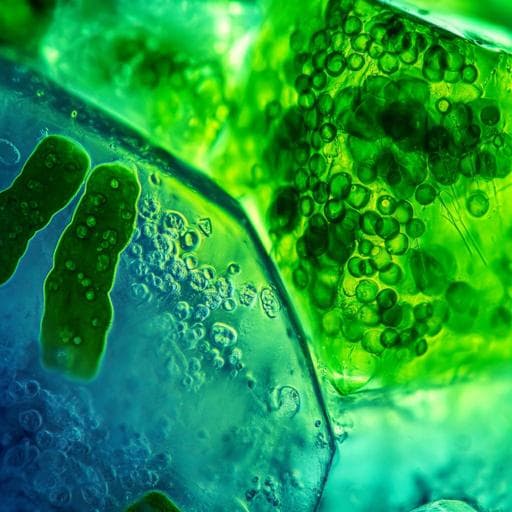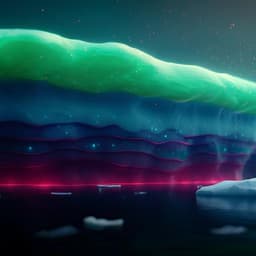
Biology
Mapping the *in situ* microspatial distribution of ice algal biomass through hyperspectral imaging of sea-ice cores
E. Cimoli, V. Lucieer, et al.
Discover how ice-associated microalgae contribute to primary production in polar regions! This innovative study, conducted by Emiliano Cimoli and colleagues, utilizes hyperspectral imaging for high-resolution mapping of phototrophic biomass in sea-ice cores, revealing astonishing insights into under-ice biophysical systems.
~3 min • Beginner • English
Introduction
Sea ice hosts diverse phototrophic and heterotrophic microbial communities. Phototrophic ice algae dominate ice-associated biomass and are key to polar primary production and food webs. The dynamic, multiphase sea-ice environment imposes strong horizontal and vertical gradients in temperature, salinity, porosity, and light, producing high variability in algal abundance, composition, and photosynthetic rates from millimeters to kilometers. Most algal biomass concentrates at the ice–water interface, but microbes also inhabit the ice interior, adding biocomplexity. Current methods lack the capability to quantify mm-scale spatio-temporal distributions of algal biomass and their physical drivers, limiting mechanistic understanding, predictive modeling, and strategic sampling. This study aims to bridge this gap by developing and validating a hyperspectral imaging (HI) and photogrammetric workflow to quantitatively map fine-scale vertical and horizontal distributions of ice algal biomass using chlorophyll a as a proxy, and by applying these bio-optical relationships to both ex situ core scans and in situ under-ice imagery.
Literature Review
Prior work has shown that under-ice biophysical variability spans micro- to mesoscales and is not satisfactorily resolved by point-based sampling. Traditional methods (ice coring, L-arm deployed radiometers, and UUV/ROV-based optical sensing) expand spatial coverage but often at coarse resolution due to large sensor footprints. Hyperspectral imaging enables per-pixel quantification of biogeochemical properties and has transformed observations in terrestrial and marine systems. Ex situ HI of cores aids in understanding spectral behavior and creating baselines complementary to in situ measurements, revealing vertical variability invisible from the surface. Recent ex situ applications include mapping impurities in glacial ice, soil organic carbon hotspots, and sedimentary pigments. Earlier studies qualitatively demonstrated sub-mm biomass variability in artificial and natural sea ice using HI but lacked quantitative, transferable relationships suitable for fine-scale imaging sensors. NDIs have been commonly used to relate under-ice spectra to Chl a, yet transferability across sites/seasons is often limited by differences in snow/ice properties and algal photophysiology, and by sensor geometry/SNR differences. This study builds on that foundation by deriving and validating spectral indices tailored to the sensor and environment, including continuum-removed, area-based indices and a logarithmic variant to address exponential light attenuation.
Methodology
Study area and sampling: A field camp at Cape Evans, Antarctica (77.637° S, 166.401° E) operated 14 Nov–5 Dec 2018. Sea-ice thickness was 180 ± 1 cm, generally snow-free with patches of thin hard snow. ROV surveys (Seabotix LBV-300) explored under-ice features. Forty-two ice cores (14 cm ID) were extracted 19 Nov–2 Dec: 22 from bare ice, 12 from thin snow (0.5–1 cm), 7 from 1–5 cm drifts, 1 from 10 cm snow. The bottom ~60 cm of each core was bagged and transferred to a darkened lab.
3D photogrammetry: Structure-from-Motion photogrammetry of selected bottom core surfaces (~0.015 m²) using a Nikon D500 + Tamron 90 mm macro lens; processing in Agisoft Metashape; models scaled using known core lengths to resolve microtopography.
Hyperspectral imaging systems: Ex situ core scanning used transmitted light. Vertical scans covered the bottom 9 cm of 6 cores; horizontal scans imaged 3 cm-thick sections: all 42 cores for 0–3 cm, and 6 selected cores also at 3–6 cm and 6–9 cm, totaling 54 horizontal sections. A Specim Aisa Kestrel 10 pushbroom camera (native 1.7 nm spectral sampling) operated without spectral binning; spatial binning reduced across-track pixels from 2048 to 1024 to boost SNR. Vertical scans: 10 Hz, 90–99 ms integration, rail speed ~0.4–0.5 cm s−1, camera ~55 cm from core centerline, across-track ~40 cm, spatial resolution ~0.39 mm, 360 pixels across core width; illumination by a solar-spectrum LED (Ed,PAR < 30 µmol photons m−2 s−1). Horizontal scans: no spectral binning, spatial binning as above. Eighteen sections used a white LED (15–20 Hz, 60–75 ms, 0.8–1.1 cm s−1); thirty-six used a solar LED (10 Hz, 90–99 ms, 0.4–0.5 cm s−1). Camera-to-surface distance ~62 cm, across-track ~45.6 cm, spatial resolution ~0.44 mm, yielding ~80,500 pixels per 0.015 m² section.
In situ under-ice imaging: A tethered under-ice HI + RGB sled captured 10–30 m transects with the same camera. At-sensor binning yielded 0.624 mm native spatial resolution and 3.5 nm spectral sampling. A representative 85 × 70 cm subset (block B) was analyzed; for processing efficiency and SNR, it was spatially binned 4×4 to 2.4 mm pixels.
Pre-processing and exploration: Raw DNs converted to radiance (Lλ). Ice-core images were masked to the sample area and spectrally subset to PAR (400–700 nm): 179 bands for core imagery and 89 bands for in situ. Horizontal core radiance was normalized to LED spectra to obtain directional transmittance T(λ) per pixel. In situ data were normalized to algae-poor cavity regions to yield pseudo-transmittance. Spectra were smoothed per pixel with a Savitzky–Golay filter (polynomial order 1–3; window 9). PCA (mean-centered) was applied separately to pooled vertical and horizontal core pixel datasets (no PCA on block B here). PC1 captured transmitted light intensity (ice transparency), PC2 captured Chl a absorption features.
Pigments and community: After imaging, sections melted in the dark at 4°C, homogenized; 50 mL subsamples filtered on GF/F filters, extracted in ethanol for 24 h; Chl a measured fluorometrically (Turner 10AU). Volumetric values converted to areal (mg m−2) using the 14 cm core area (0.015 m²). Species composition by light microscopy (400×).
Spectral indices and regression: For each horizontal section, spectral indices were computed using method (2): per-pixel index values averaged over the section. Indices included NDIs across all wavelength pairs (400–700 nm) with optimal pairs selected via Pearson correlation surfaces with constraints (|ρ| > 0.7, separation > 12 nm, inclusion of Chl a absorption bands). Additional indices from continuum-removed spectra over 650–700 nm: AUC650–700; ANCB650–700 = AUC650–700 normalized by constant band depth at 677 nm; ANMB650–700 = AUC650–700 normalized by maximum band depth; and LAUC650–700 = log(AUC650–700) to account for exponential attenuation. Linear models related log(Chl a [mg m−2]) to each index. Models were evaluated by R², adjusted R², RMSE, AIC, and 10-fold cross-validation (reporting CV R² and RMSE).
Mapping and spatial analysis: The best-performing model was applied per pixel to selected ex situ horizontal sections and to the in situ block B pseudo-transmittance image to generate quantitative Chl a maps (mg m−2) at ≤2.4 mm resolution. Spatial autocorrelation was assessed via an empirical variogram (lags 1.2 cm; 10,000 randomly sampled pixels). Micro-scale variability was examined by gradient magnitude (Prewitt operator).
Key Findings
- Biomass distribution: For 42 bottom sections (0–3 cm), mean Chl a = 18.74 ± 18.04 mg m−2 (range 1.1–117.5). Mid-core (3–6 cm, n=6): 0.61 ± 0.40 mg m−2 (0.13–1.2). Top (6–9 cm, n=6): 0.64 ± 0.48 mg m−2 (0.14–1.35). Biomass is highly concentrated in the bottom 0–3 cm.
- PCA: PC1 explained >99.8% variance and mapped transmitted light intensity (ice transparency). PC2 explained <0.05% and resembled Chl a absorption (peaks ~440 and ~670 nm), providing an unsupervised proxy for biomass distribution in vertical and horizontal sections.
- Spectral indices and regressions: Optimal NDIs were NDI(587,621) and NDI(517,449). Continuum-removed indices outperformed NDIs. LAUC650–700 achieved the best calibration (R² = 0.840; adj R² = 0.836; RMSE = 0.660 log-units; AIC = 110.327) and cross-validation performance (CV R² = 0.837; CV RMSE = 0.664). ANMB650–700 and ANCB650–700 also performed well (adj R² = 0.777 and 0.704, respectively). AUC650–700 and NDIs showed saturation at medium–high biomass.
- Imaging resolution and mapping: Ex situ sections mapped at ~0.44 mm pixels; in situ block B at 2.4 mm pixels. Per-pixel quantitative Chl a maps revealed strong microspatial patchiness within individual cores and across locations meters apart; core means within 10 m differed by an order of magnitude (e.g., core 30: 3.37 mg m−2 vs core 24: 23.12 mg m−2).
- Spatial structure in situ: Variogram range ~12 cm, indicating autocorrelation at the scale of cavities and algal clusters; high nugget suggests unresolved mm-scale variability and measurement noise. Gradient magnitudes averaged 3.3 ± 2.3 mg m−2 mm−1 with maxima up to 18 mg m−2 mm−1, indicating very sharp biomass gradients.
- Community and habitat: Under-ice habitat displayed widespread large cavities (3–15 cm diameter) and brine-channel openings; dominant diatoms were Nitzschia stellata (interstitial) and Berkeleya adeliensis (strand-forming), with strand webs spanning cavities; biomass patterns aligned with permeable skeletal layers and brine structures.
Discussion
The study demonstrates that hyperspectral imaging of sea-ice cores, paired with appropriately designed spectral indices, can quantitatively resolve mm-scale spatial variability of ice algal biomass and effectively bridge the gap between traditional coarse sampling and the fine scales at which key biophysical processes occur. PCA provided an unsupervised means to disentangle illumination/transparency from chlorophyll absorption, highlighting vertical and horizontal biomass patterns without ancillary pigment data. The log-transformed continuum-removed area index (LAUC650–700) captured the exponential attenuation inherent to light transmission through absorbing, scattering ice, yielding strong and robust relationships with extracted Chl a and enabling per-pixel biomass mapping both ex situ and in situ. Application to an under-ice image subset revealed characteristic autocorrelation scales (~12 cm) linked to habitat features (cavities, algal clusters) and extremely sharp gradients at mm scales, underscoring the ecological complexity and the need for high-resolution monitoring. These fine-scale maps complement and can inform larger-scale surveys by providing mechanistic insights into how ice microstructure and topography shape algal distributions, supporting better parameterization of biogeochemical and ecological models.
Conclusion
This work advances under-ice observation by introducing a field-deployable hyperspectral scanning and photogrammetric workflow that quantitatively maps sea-ice algal chlorophyll a at mm-scale resolution. Novel continuum-removed, area-based indices—especially the logarithmic LAUC650–700—provided strong predictive power (R² up to 0.84; robust cross-validation), suitable for per-pixel application to both ex situ core sections and in situ under-ice imagery. The approach reveals pronounced microspatial patchiness and characteristic autocorrelation scales, highlighting the importance of resolving processes at these scales. Future research should: (1) develop validation techniques at mm–cm scales (e.g., miniaturized sampling, PAM imaging co-registered with HI); (2) extend datasets across seasons, ice types, and regions to improve model robustness and transferability via statistical learning; (3) integrate concurrent microphysical measurements (temperature, salinity, porosity) and 3D topography to link biomass to habitat drivers; (4) adapt workflows for environments lacking cavity references (e.g., radiative transfer normalization) and deeper vertical sections; and (5) deploy HI on UUVs or stationary platforms for scalable spatial and temporal monitoring.
Limitations
- Validation at mm-scale remains challenging due to lack of sampling methods matching HI pixel sizes; core extraction can cause biomass loss (especially strand-forming diatoms), complicating ground truthing.
- Models were derived from 3 cm-thick bottom sections and applied assuming >98% biomass resides there; transfer to ice types with different vertical biomass distributions may require additional vertical sections.
- Study site conditions (snow-free fast ice, absence of platelet ice) and light environment favored 650–700 nm indices; snow presence or different ice textures may reduce performance in that range.
- Index saturation observed for NDIs and simple AUC at medium–high biomass; ANCB/ANMB may underperform at very low biomass where background dominates.
- PCA separation may be less straightforward in ice with mixed textures (granular vs columnar) or complex biogeochemistry (detritus, sediments, CDOM).
- In situ pseudo-transmittance normalization relies on algae-poor cavity regions; sites lacking such features may require alternative normalization (e.g., radiative transfer modeling).
Related Publications
Explore these studies to deepen your understanding of the subject.







